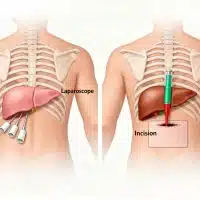
Trigeminal Neuralgia (TN), or tic douloureux, is a painful condition. It affects a nerve in your face and causes sudden, severe pain. This pain can feel like an electric shock. It can make daily tasks hard. It can also impact your emotions and how you connect with others.
What are the Causes of Trigeminal Neuralgia?
The main reason for classic Trigeminal Neuralgia is pressure on the trigeminal nerve. This happens close to where the nerve joins the brainstem. This pressure usually comes from a small blood vessel pressing on the nerve. This pressure can harm the myelin, the protective covering of nerve fibers. If myelin is damaged, the nerve may not work properly and can send strong pain signals. The area where the outer and inner myelin meet is especially sensitive to this kind of damage.
Sometimes, Trigeminal Neuralgia can be caused by another health problem. This condition is called secondary Trigeminal Neuralgia. It can arise in cases like multiple sclerosis (MS), which harms the myelin around nerves. Tumors pressing on the trigeminal nerve, strokes, or injuries to the face can also cause it. Younger people with TN symptoms should be checked for MS. In secondary TN, people might have a more constant background pain along with the sudden bursts of pain.
There are some things that can make it more likely for someone to get Trigeminal Neuralgia. It’s more common in people over 50. Women are also more likely to get it than men. People who already have conditions like high blood pressure and multiple sclerosis have a higher risk. Some studies show that education, sleep length, and anxiety or depression could affect the chances of developing TN.
Recognizing the Diverse Symptoms of Trigeminal Neuralgia
The pain from Trigeminal Neuralgia is often described as sudden, short, and very intense, like an electric shock, a stab, or a shooting pain. People might have these painful episodes many times a day. Usually, the pain doesn’t last long, from just a moment to about 2 minutes.
A key sign of TN is that the pain almost always happens on only one side of the face at a time. The pain follows the path of one or more of the three parts of the trigeminal nerve, which give feeling to different areas of the face: the ophthalmic (V1), maxillary (V2), and mandibular (V3) divisions. The cheek, jaw, teeth, gums, and lips are most commonly affected. Pain only in the eye and forehead area (ophthalmic division) is less common. It’s also more common to have symptoms on the right side of the face.
One unique aspect of Trigeminal Neuralgia is that normal activities can trigger pain. Triggers can vary for each person. Some common ones are a light touch on the face, washing your face, brushing teeth, eating, drinking, talking, smiling, shaving, or feeling cold air. Many people have certain spots on their face, known as trigger zones. Even a light touch there can trigger an attack.
How often the pain attacks happen can vary a lot from person to person. Some might have just a few episodes a day, while others might have hundreds in severe cases. The condition often comes and goes, with periods of intense pain followed by times with little or no pain. However, for many people, the pain tends to happen more often and be more severe over time. Interestingly, pain episodes rarely happen when someone is sleeping.
Exploring Effective Treatment Methods for Trigeminal Neuralgia
The first step in treating Trigeminal Neuralgia is often medication. These drugs work to reduce or block the pain signals along the trigeminal nerve. Carbamazepine is a common first choice and has been shown to be effective in controlling TN pain. Other anti-seizure medications like oxcarbazepine, lamotrigine, phenytoin, topiramate, pregabalin, and gabapentin might also be used. These drugs help by making nerve activity more stable and less likely to send pain signals. Sometimes, muscle relaxants like baclofen are used alone or with anti-seizure drugs. Some studies show that Botox injections can ease pain for people who don’t find relief from regular medications.
When medications don’t work well enough or cause too many side effects, surgery or other procedures might be needed. There are a few surgical options. One is microvascular decompression (MVD). In this procedure, surgeons relieve pressure on the trigeminal nerve. They do this by moving or removing blood vessels that press on it. Another option is stereotactic radiosurgery, known as Gamma Knife. This method doesn’t require surgery. It uses focused radiation to damage the trigeminal nerve root, helping to reduce pain. There are also percutaneous procedures. These involve putting a needle through the cheek to reach the trigeminal nerve.
These methods include:
- Glycerol injection: A special fluid is injected around the nerve to block pain.
- Balloon compression: A small balloon squeezes the nerve to relieve pressure.
- Radiofrequency ablation (RFA): Heat is used to stop pain signals.
| Drug | Mechanism of Action | Common Side Effects | Key Considerations |
| Carbamazepine | VGSC blocker, L-type VGCC blocker | Drowsiness, dizziness, diplopia, nausea, SJS/TEN risk | First-line, requires HLA-B*15:02 testing in Asian ancestry, metabolic interactions |
| Oxcarbazepine | VGSC blocker; N-P- and R-type VGCC blocker | Diplopia, dizziness, hyponatremia, SJS/TEN risk | Fewer drug interactions than carbamazepine, also avoid in HLA-B*15:02 positive individuals |
| Lamotrigine | VGSC blocker, N-P-type VGCC blocker | Rash (including SJS/TEN), dizziness | Can be used if carbamazepine/oxcarbazepine not tolerated, slow dose titration needed |
| Gabapentin | Cavα2δ subunit modulator | Vertigo, confusion, sedation | Less effective than oxcarbazepine as first-line |
| Baclofen | GABAB receptor agonist | Dizziness, sedation, dyspepsia | Muscle relaxant, can be used alone or with carbamazepine |
Radiofrequency Ablation (RFA): A Minimally Invasive Treatment for Trigeminal Neuralgia
Radiofrequency Ablation (RFA) is a simple, low-risk treatment for Trigeminal Neuralgia. This method uses radio waves to generate heat. This heat carefully targets the nerve fibers in the trigeminal nerve that cause pain. The procedure is usually done with local anesthesia, and many people can go home the same day.
In the RFA procedure, a thin needle with an electrode goes through the skin of the face. It is then guided to the Gasserian ganglion. This ganglion is a group of nerve cells at the base of the skull where the three parts of the trigeminal nerve meet. Doctors use a special type of X-ray called fluoroscopy to see exactly where the needle is going. Once the needle is in the right place, radiofrequency energy is sent through the tip of the needle. This creates heat in a small area, which stops the targeted nerve fibers from sending pain signals.
RFA has helped many people with Trigeminal Neuralgia. Some studies show it has high success rates in relieving pain. It’s often a great option, especially for those who haven’t found relief from medications or can’t have more complex surgeries. A study even showed that RFA worked much better than a fake procedure in reducing pain after one month.
There are different ways to do RFA, including continuous radiofrequency (CRF) and pulsed radiofrequency (PRF). CRF uses a constant heat to create a small area of damage, while PRF uses short bursts of energy at lower temperatures. Some research suggests that using both CRF and PRF might be the most effective for controlling pain.
While RFA can be very helpful, it’s important to know what to expect. It might not work for everyone, especially if the pain is in many areas of the face. A common side effect is numbness in the treated area of the face. This can last for a short time or, in some cases, be permanent. Other rare issues may include weak chewing muscles, a lower blink reflex, and dry eyes. It’s also possible for the pain to come back for some people over time.
Navigating Life After Treatment: Post-Treatment Care for Trigeminal Neuralgia
After getting treatment for Trigeminal Neuralgia, it’s important to have ongoing care to stay well in the long run. Regular check-ups with your doctors are important to see how well the treatment worked, deal with any side effects, and manage if the pain comes back. Because TN can come and go, long-term follow-up helps make sure the treatment was successful.
Even if the treatment, like RFA, worked well, the pain can sometimes return. If this happens, there are other treatment options, like repeating the RFA procedure or trying other surgeries or procedures. It’s important to talk to your healthcare team about these possibilities and make a plan.
Managing any side effects is also a key part of post-treatment care. For example, facial numbness is common after RFA. People might need advice on how to adjust their daily routines to cope with this change in sensation and avoid injuries.
Living with chronic pain can really affect your mental and emotional health. So, it’s important to address these aspects after treatment. Getting support from therapists or joining Trigeminal Neuralgia support groups can be helpful. Worrying about pain returning and the burden of the condition can cause anxiety and depression. So, psychological support is key to overall care. Pain management programs often offer these resources.
Making healthy lifestyle choices can also help you feel better after treatment. This includes getting regular exercise if you can, eating a healthy diet, and finding ways to manage stress. These things can improve your overall health and help you cope with chronic pain.
Considering Advanced Pain Management at BIMC Nusa Dua
BIMC Nusa Dua has a special Pain Clinic that focuses on finding the cause of different types of pain, including nerve pain and long-lasting conditions like Trigeminal Neuralgia, and providing various treatments. Their Pain Management Program includes treatments like Radiofrequency Ablation (RFA) for people with TN who are good candidates for it.
If you think you might have Trigeminal Neuralgia or are looking for advanced pain management options like RFA, you can contact BIMC Nusa Dua to talk to their pain specialists.
Meet Dr. Cindy H. Nasrani: An Expert in Pain Management
Dr. Cindy H. Nasrani is a highly qualified Anesthesiologist and Pain Specialist practicing at BIMC Nusa Dua. She obtained her medical degree from Universitas Kristen Krida Wacana in 2003 and furthered her specialization by completing her anesthesiology residency and a Master’s degree at Universitas Udayana in Bali in 2014.
Dr. Nasrani has pursued extensive specialized training in pain management, earning board certification in the Fellowship of Interventional Pain Management (FIPM) from the Indonesian College of Anesthesiology and Intensive Therapy in 2017. Demonstrating her international expertise, she also achieved the Fellowship of Interventional Pain Practice (FIPP) from the World Institute of Pain in Istanbul in 2019. Her comprehensive training and certifications highlight her proficiency in performing advanced interventional pain procedures, including Radiofrequency Ablation for conditions such as Trigeminal Neuralgia. Dr. Nasrani is also dedicated to advancing the field of pain management through her involvement in educational workshops for other healthcare professionals. Her vision focuses on making sure chronic pain patients get top-quality care and support. This helps them on their journey to find pain relief and improve their functionality.











